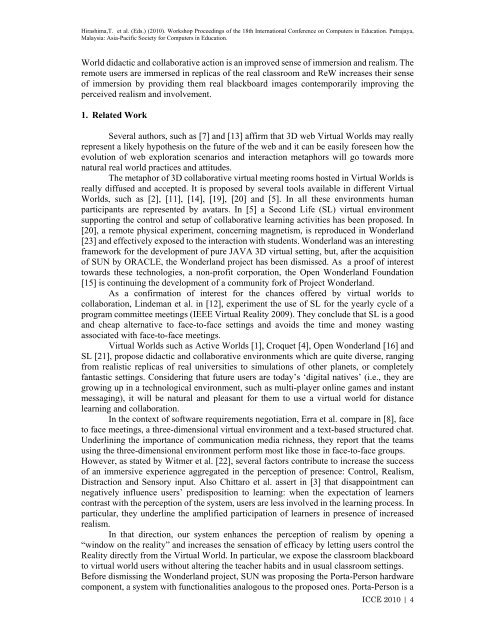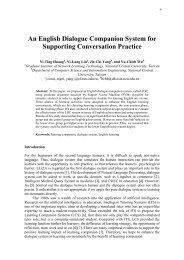ICCE2010 Workshop Proceedings - APSCE Asia-Pacific Society for ...
ICCE2010 Workshop Proceedings - APSCE Asia-Pacific Society for ...
ICCE2010 Workshop Proceedings - APSCE Asia-Pacific Society for ...
Create successful ePaper yourself
Turn your PDF publications into a flip-book with our unique Google optimized e-Paper software.
Hirashima,T. et al. (Eds.) (2010). <strong>Workshop</strong> <strong>Proceedings</strong> of the 18th International Conference on Computers in Education. Putrajaya,<br />
Malaysia: <strong>Asia</strong>-<strong>Pacific</strong> <strong>Society</strong> <strong>for</strong> Computers in Education.<br />
World didactic and collaborative action is an improved sense of immersion and realism. The<br />
remote users are immersed in replicas of the real classroom and ReW increases their sense<br />
of immersion by providing them real blackboard images contemporarily improving the<br />
perceived realism and involvement.<br />
1. Related Work<br />
Several authors, such as [7] and [13] affirm that 3D web Virtual Worlds may really<br />
represent a likely hypothesis on the future of the web and it can be easily <strong>for</strong>eseen how the<br />
evolution of web exploration scenarios and interaction metaphors will go towards more<br />
natural real world practices and attitudes.<br />
The metaphor of 3D collaborative virtual meeting rooms hosted in Virtual Worlds is<br />
really diffused and accepted. It is proposed by several tools available in different Virtual<br />
Worlds, such as [2], [11], [14], [19], [20] and [5]. In all these environments human<br />
participants are represented by avatars. In [5] a Second Life (SL) virtual environment<br />
supporting the control and setup of collaborative learning activities has been proposed. In<br />
[20], a remote physical experiment, concerning magnetism, is reproduced in Wonderland<br />
[23] and effectively exposed to the interaction with students. Wonderland was an interesting<br />
framework <strong>for</strong> the development of pure JAVA 3D virtual setting, but, after the acquisition<br />
of SUN by ORACLE, the Wonderland project has been dismissed. As a proof of interest<br />
towards these technologies, a non-profit corporation, the Open Wonderland Foundation<br />
[15] is continuing the development of a community <strong>for</strong>k of Project Wonderland.<br />
As a confirmation of interest <strong>for</strong> the chances offered by virtual worlds to<br />
collaboration, Lindeman et al. in [12], experiment the use of SL <strong>for</strong> the yearly cycle of a<br />
program committee meetings (IEEE Virtual Reality 2009). They conclude that SL is a good<br />
and cheap alternative to face-to-face settings and avoids the time and money wasting<br />
associated with face-to-face meetings.<br />
Virtual Worlds such as Active Worlds [1], Croquet [4], Open Wonderland [16] and<br />
SL [21], propose didactic and collaborative environments which are quite diverse, ranging<br />
from realistic replicas of real universities to simulations of other planets, or completely<br />
fantastic settings. Considering that future users are today’s ‘digital natives’ (i.e., they are<br />
growing up in a technological environment, such as multi-player online games and instant<br />
messaging), it will be natural and pleasant <strong>for</strong> them to use a virtual world <strong>for</strong> distance<br />
learning and collaboration.<br />
In the context of software requirements negotiation, Erra et al. compare in [8], face<br />
to face meetings, a three-dimensional virtual environment and a text-based structured chat.<br />
Underlining the importance of communication media richness, they report that the teams<br />
using the three-dimensional environment per<strong>for</strong>m most like those in face-to-face groups.<br />
However, as stated by Witmer et al. [22], several factors contribute to increase the success<br />
of an immersive experience aggregated in the perception of presence: Control, Realism,<br />
Distraction and Sensory input. Also Chittaro et al. assert in [3] that disappointment can<br />
negatively influence users’ predisposition to learning: when the expectation of learners<br />
contrast with the perception of the system, users are less involved in the learning process. In<br />
particular, they underline the amplified participation of learners in presence of increased<br />
realism.<br />
In that direction, our system enhances the perception of realism by opening a<br />
“window on the reality” and increases the sensation of efficacy by letting users control the<br />
Reality directly from the Virtual World. In particular, we expose the classroom blackboard<br />
to virtual world users without altering the teacher habits and in usual classroom settings.<br />
Be<strong>for</strong>e dismissing the Wonderland project, SUN was proposing the Porta-Person hardware<br />
component, a system with functionalities analogous to the proposed ones. Porta-Person is a<br />
ICCE 2010 | 4



